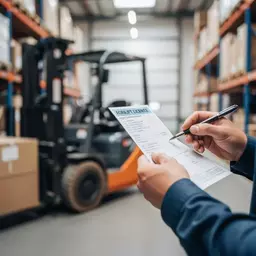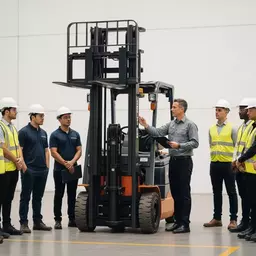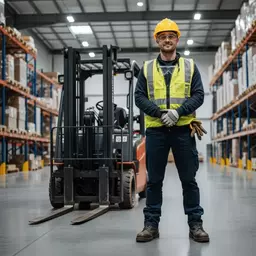Have you ever considered how the safety of pedestrians is often overlooked in busy environments where forklifts operate? Understanding pedestrian safety in these contexts is crucial for preventing accidents and ensuring a secure workplace for everyone involved.
What You Will Learn
- Pedestrian safety is essential to prevent forklift-related accidents, which account for approximately 34% of injuries.
- Clear communication between operators and pedestrians significantly reduces risks in forklift operations.
- Regular training and compliance checks are vital for maintaining a culture of safety in workplaces.
- Implementing designated walkways and appropriate signage enhances visibility and safety for all individuals on-site.
Forklift Pedestrian Safety: Key Statistics and Best Practices
Understanding the critical aspects of pedestrian safety around forklifts is essential for preventing workplace accidents. The visual below highlights key accident statistics and the foundational pillars for a safer work environment. For more detailed insights into regulations, you might want to check out the LF vs LO Forklift Licence Requirements.
Workplace Accident Statistics
34%
of forklift-related injuries due to pedestrian collisions.
This highlights the urgent need for rigorous safety protocols and training to minimize risks and protect workers.
Key Pillars of Pedestrian Safety
- Designated Pedestrian Walkways
- Regular Training for All Employees
- Effective Signage & Communication
- Proactive Risk Assessments
Understanding Pedestrian Safety Around Forklifts
When it comes to operating forklifts, pedestrian safety is a critical consideration that cannot be overlooked. As someone deeply involved in the forklift licensing industry, I can’t stress enough how essential it is for both operators and pedestrians to be vigilant and informed. After all, safety on the worksite is a shared responsibility! Understanding the dynamics of pedestrian safety can help prevent accidents and create a safer workplace for everyone involved.
The Importance of Pedestrian Safety in Forklift Operations
In busy environments where forklifts are in operation, pedestrians frequently find themselves sharing space with heavy machinery. This makes the importance of pedestrian safety paramount. Companies must prioritize safety protocols to protect workers, as failing to do so can result in serious accidents and injuries.
- Increased risk of accidents when safety guidelines are ignored
- Need for clear communication between operators and pedestrians
- Importance of training programs to educate all personnel
By implementing well-defined safety measures, we can significantly reduce the potential for accidents and create a more efficient working environment. Remember, safety isn't just a set of rules; it’s about fostering a culture where everyone looks out for one another! For more information on maintaining a safe environment, consider these Forklift Safety Rules for Operators.
Statistics on Workplace Accidents Involving Forklifts
According to recent studies, forklift accidents account for a significant percentage of workplace injuries. In fact, the Occupational Safety and Health Administration (OSHA) reports that approximately 34% of forklift-related injuries occur due to pedestrian collisions. This staggering statistic highlights the need for rigorous safety protocols and training to minimize risks.
Furthermore, understanding these statistics can help businesses recognize the urgency of implementing safety measures. By making pedestrian safety a priority, we can save lives and create a healthier working environment.
Consequences of Neglecting Safety Protocols
Neglecting safety protocols can lead to devastating consequences, not only for the individuals affected but also for the organization as a whole. Here are some potential outcomes:
- Increased employee injuries, leading to lost workdays
- Legal consequences and potential fines from regulatory bodies
- Damage to company reputation and employee morale
As I've seen in my experience, the repercussions of ignoring safety measures can be far-reaching. It’s crucial for all team members to be aware of their responsibilities and actively participate in creating a safe work environment!
OSHA Requirements for Forklift Pedestrian Safety
When it comes to forklift pedestrian safety, adhering to OSHA guidelines is essential. These regulations are designed to ensure that both operators and pedestrians are protected from potential hazards in the workplace. Understanding these requirements is the first step toward compliance and safety!
Key OSHA Standards Every Workplace Must Follow
OSHA provides clear standards that must be followed to promote pedestrian safety around forklifts. Here are some of the key regulations:
- Establishing designated pedestrian walkways
- Implementing proper training for all employees
- Utilizing appropriate signage to alert pedestrians and operators
Following these guidelines ensures that everyone is aware of the risks and knows how to navigate the workplace safely. It’s all about creating an environment where safety is the norm!
Marked Walkways and Signage for Enhanced Visibility
One of the most effective ways to enhance pedestrian safety is through clearly marked walkways and appropriate signage. Signage should be placed strategically to ensure maximum visibility to both operators and pedestrians. This helps in guiding individuals through busy areas and reducing the chances of accidents.
Think of it this way: visual aids can significantly improve awareness and communication among all workers on-site. The clearer the pathways, the more likely everyone will be able to navigate safely!
Regular Training and Compliance Checks
Regular training sessions are vital in maintaining safety around forklifts. Training programs should cover:
- Proper forklift operation techniques
- Understanding pedestrian rights and responsibilities
- Emergency procedures in case of an accident
By conducting compliance checks and refresher courses, we can ensure that everyone stays informed about safety protocols. This ongoing education is essential for a culture of safety in any organization. You can find more useful guidance in our Forklift Licence Training Guide Australia.
Understanding OSHA Guidelines for Forklift Operation
Understanding OSHA guidelines goes beyond just compliance; it’s about fostering a culture of safety. When everyone is aware of the rules, it leads to better communication and overall harmony in the workplace. Regularly reviewing these guidelines and ensuring they are integrated into daily operations is key!
As we continue on this journey of safety, let’s keep in mind that it’s our shared responsibility to ensure everyone goes home safe at the end of the day. Let's prioritize pedestrian safety around forklifts and make our work environments safer for everyone involved!
Did You Know?
Approximately 34% of forklift-related injuries occur due to pedestrian collisions. This highlights the critical need for effective safety protocols and training in your workplace!
Frequently Asked Questions About Forklift Pedestrian Safety
- What percentage of forklift-related injuries are due to pedestrian collisions?
- Approximately 34% of forklift-related injuries occur due to pedestrian collisions, emphasizing the need for robust safety protocols.
- What are the key pillars of pedestrian safety around forklifts?
- The key pillars include designated pedestrian walkways, regular training for all employees, effective signage and communication, and proactive risk assessments.
- Why is communication important between forklift operators and pedestrians?
- Clear communication significantly reduces risks by ensuring both parties are aware of each other's presence and intentions, preventing accidents.
- What role does OSHA play in forklift pedestrian safety?
- OSHA sets clear standards and guidelines that workplaces must follow, including establishing designated walkways, implementing training, and using appropriate signage, to protect both operators and pedestrians.
- How can workplaces foster a safety-first culture?
- Workplaces can foster a safety-first culture by promoting open communication, recognizing safe behaviors, encouraging team collaboration on safety challenges, and ensuring management leads by example.
Summarizing Key Takeaways for Forklift Pedestrian Safety
As we wrap up our discussion on forklift pedestrian safety, it’s essential to highlight the key tips that can significantly reduce workplace accidents. Implementing these best practices in your daily operations will not only enhance safety but also foster a culture of responsibility and awareness. Here are some vital takeaways:
- Always prioritize the establishment of marked walkways.
- Ensure clear and consistent communication between operators and pedestrians.
- Regularly conduct training sessions and compliance checks for all staff.
- Utilize visual and audible signals effectively in high-traffic areas.
Integrating these practices into your workplace can create a safer environment for everyone. Remember, safety is not a one-time effort but an ongoing commitment that requires collective engagement from both operators and pedestrians alike.
Reviewing the Essential Tips for Preventing Workplace Accidents
In order to effectively prevent accidents, it’s crucial to continuously review and adapt your safety measures. Here are some essential aspects to consider:
- Implementing right-of-way rules for pedestrians.
- Conducting regular risk assessments to identify potential hazards.
- Utilizing spotters in high-risk areas for enhanced oversight.
By focusing on these aspects, you can create a proactive approach to safety. Regular assessments and updates to your protocols ensure that you stay ahead of potential risks and foster a culture of vigilance.
Integrating Best Practices into Daily Operations
To truly make safety a priority, it’s important to weave these best practices into the very fabric of your operations. This includes:
- Establishing a safety checklist for daily forklift operations.
- Encouraging staff to report near misses and unsafe conditions.
- Regularly reviewing and updating safety signage around the workplace.
When these practices become routine, they help ensure that everyone is on the same page when it comes to safety. Plus, fostering open communication can lead to valuable insights that improve safety protocols.
The Importance of Regular Training and Compliance
Ongoing training is vital for maintaining high safety standards. Remember, the workplace is always evolving, and keeping everyone informed is key!
- Schedule regular training sessions for both new and existing employees.
- Provide refresher courses on safety protocols and equipment operation.
- Stay updated on industry regulations and implement necessary changes, such as the 2025 Australian Forklift Licence Changes.
At Forklift Licence Insights, I often emphasize that knowledge is power—empower your team by equipping them with the right skills and understanding!
Conducting Risk Assessments for Safer Work Environments
Conducting thorough risk assessments is essential for identifying potential hazards in your workplace. This allows you to take proactive measures to mitigate risks. Here’s how:
- Identify high-traffic areas and assess pedestrian exposure.
- Evaluate the current safety measures in place and their effectiveness.
- Gather feedback from employees about their safety concerns.
Regular risk assessments help your workplace stay informed and ready to tackle new challenges. And don’t forget—involving your staff in this process can generate valuable insights!
Encouraging a Safety-First Culture in Your Workplace
Creating a culture that prioritizes safety is not just beneficial for compliance; it's vital for the well-being of every worker. Here are some steps to implement a robust safety-first culture:
- Promote open communication about safety concerns.
- Recognize and reward safe behaviors.
- Encourage team collaboration to solve safety challenges.
By actively promoting safety as a shared responsibility, you empower everyone in the workplace to play their part in maintaining a safe environment.
Steps to Foster a Culture of Safety Among Staff
The role of management in enforcing safety standards cannot be overstated. Here are some steps every leader should take:
- Lead by example with a commitment to safety protocols.
- Provide resources and training necessary for safe operations.
- Establish clear consequences for ignoring safety measures.
When management demonstrates a genuine commitment to safety, it sets the tone for the entire organization. As I like to say, leadership matters when it comes to cultivating a safety-first mindset!
The Role of Management in Enforcing Safety Standards
Management should actively engage in safety initiatives. Here’s how you can enforce safety standards:
- Regularly review safety protocols and update them as needed.
- Communicate any changes or updates promptly to all staff.
- Encourage feedback from employees to improve safety measures.
By being approachable and responsive, management can foster a culture where safety is prioritized and valued.
Resources for Ongoing Training and Awareness
To keep safety at the forefront, it's important to provide ongoing resources for training. Consider these options:
- Utilizing online training modules for flexibility.
- Hosting safety workshops and seminars.
- Providing access to informative articles and guides, such as those on Forklift Licence Insights.
Regular training ensures that everyone is equipped with the latest safety knowledge, keeping your workplace safe and compliant.
Developing Workplace Safety Programs for Continuous Improvement
Continuous improvement in safety protocols is a sign of a proactive workplace. Implement these strategies:
- Establish a safety committee to oversee safety initiatives.
- Conduct regular safety audits to assess compliance.
- Engage employees in developing new safety programs.
By developing a comprehensive safety program, you create an environment where safety is ingrained in daily operations. Together, we can prioritize safety and make a difference!
Call to Action: Prioritize Safety Today
Now that we've explored the many facets of forklift pedestrian safety, it’s time to take action! Here’s how you can get started:
- Review your current safety protocols and make necessary adjustments.
- Engage your team in safety discussions and training.
- Download resources and guides from Forklift Licence Insights to enhance your safety knowledge.
Remember, the safety of your workplace is a shared responsibility. Let’s work together to ensure everyone goes home safe at the end of the day!
How to Get Started with Implementing These Safety Tips
Implementing these safety tips is easier than you might think! Start by:
- Setting up a schedule for regular safety training sessions.
- Involving your team in creating a safety checklist.
- Encouraging reporting and discussion of safety issues.
Taking these first steps shows your commitment to safety and helps create a secure work environment.
Downloadable Resources for Enhanced Safety Awareness
To support your safety initiatives, I’ve compiled some valuable resources that can help:
- Safety checklist templates.
- Forklift safety training manuals.
- Guides on compliance with OSHA standards.
Feel free to explore these resources on Forklift Licence Insights and share them with your team. Let’s make safety a priority today!
Recap of Key Points
Here is a quick recap of the important points discussed in the article:
- Prioritize the establishment of marked walkways to enhance pedestrian safety.
- Ensure clear communication between forklift operators and pedestrians to prevent accidents.
- Conduct regular training sessions and compliance checks for all staff members.
- Utilize visual and audible signals effectively in high-traffic areas to improve awareness.
- Implement right-of-way rules for pedestrians and conduct regular risk assessments.
- Promote a safety-first culture by recognizing safe behaviors and encouraging collaboration.







